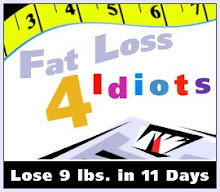
Speed Eating and Fat Loss: Diet Advice Your Mom Was Right About All Along
By Tom Venuto, NSCA-CPT, CSCS
www.BurnTheFat.com
A new study just published in a recent issue of the journal Obesity has revealed that thin people eat very differently than heavy people at all-you-can-eat buffet restaurants.
Researcher Brian Wansink and his team from the Cornell University Food and Brand Laboratory observed diners at 11 different Chinese buffet restaurants across the United States.
Their goal was to find out whether the eating behaviors of people at all-you-can-eat buffets varied based on their body mass.
Trained observers recorded the height, weight, gender, age, and behavior of 213 patrons. The various seating, serving and eating behaviors were then compared across BMI levels.
The heavier (higher BMI) patrons:
ate more quickly
chewed more food per bite
used forks
sat facing the food buffet
The thin (lower BMI) patrons:
ate more slowly
chewed less food per bite
used chopsticks
sat facing away from the food buffet
This study confirms earlier research from the University of Rhode Island published in the journal of the American Dietetic Association which found that eating slowly leads to decreases in energy intake.
Scientists even have a name for this now:
"TIME-ENERGY DISPLACEMENT"
Time-Energy Displacement means that the more time you take to eat, the less energy (calories) you are likely to consume. The faster you eat, the more energy (calories) you’re likely to consume.
But wait, there’s even more! A study from the University of Alabama looked at satiety (how full a food makes you feel), energy density (calories per unit of volume) and eating time of various foods. To maximize the effects of Time-Energy Displacement, it was found even more advantageous to choose foods that FORCE you to ingest calories more slowly.
This includes choosing more:
Foods that have a high satiety factor such as high fiber and high water foods (so you feel fuller more quickly):
Peas
Red beans
Raspberries
Broccoli
Green beans
Chick Peas
Foods with a high “chew factor” (so you can’t eat them fast if you tried; you have to chew them thoroughly):
Lean meats such as top round, lean sirloin
Celery
Apples
Pears
Peaches
Foods with a low energy density such as salad vegetables and greens (so you’d get tired of eating before you took in a lot of calories):
Tomatoes
Artichoke
Cucumber
Salad Greens
Cabbage
Okra
These results also confirm all the studies that have been advising us not to drink our calories. Liquid calories, especially soft drinks and dessert coffees are two of the biggest sources of excess calories in the typical American’s diet.
The problem: calories in liquid form can have a very high caloric density and can be consumed very quickly. Liquid calories also do not activate the satiety mechanism in your brain and gastrointestinal tract the way solid food does.
"Don't inhale your food" used to be an admonishment about proper eating etiquette you heard from your mom. It is now scientifically-proven fat loss advice.
To learn more research-proven tips for burning fat, visit the “Burn The Fat” website at www.BurnTheFat.com
Train hard and expect success,
Tom Venuto
Fat Loss Coach
www.BurnTheFat.com
About the Author:
Tom Venuto is a natural bodybuilder, certified personal trainer and freelance fitness writer. Tom is the author of "Burn the Fat, Feed The Muscle,” which teaches you how to get lean without drugs or supplements using secrets of the world's best bodybuilders and fitness models. Learn how to get rid of stubborn fat and increase your metabolism by visiting: www.burnthefat.com










No comments:
Post a Comment